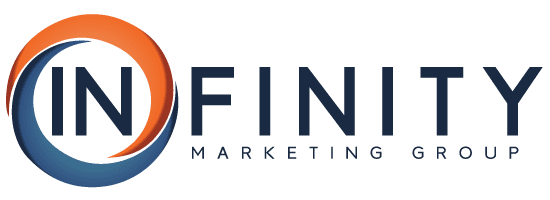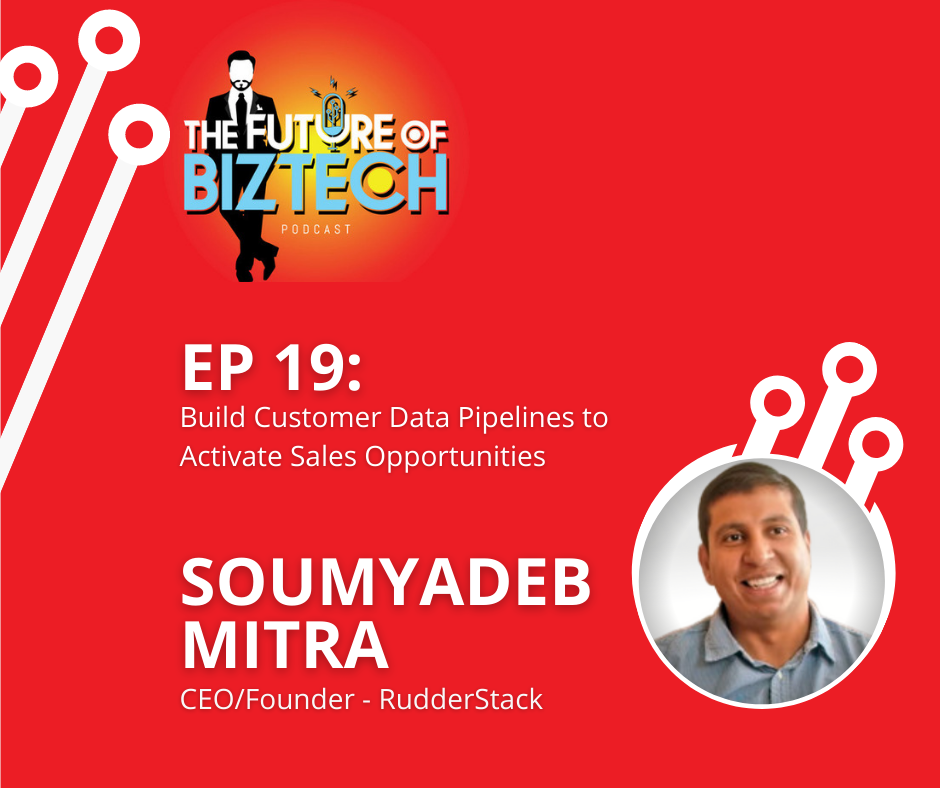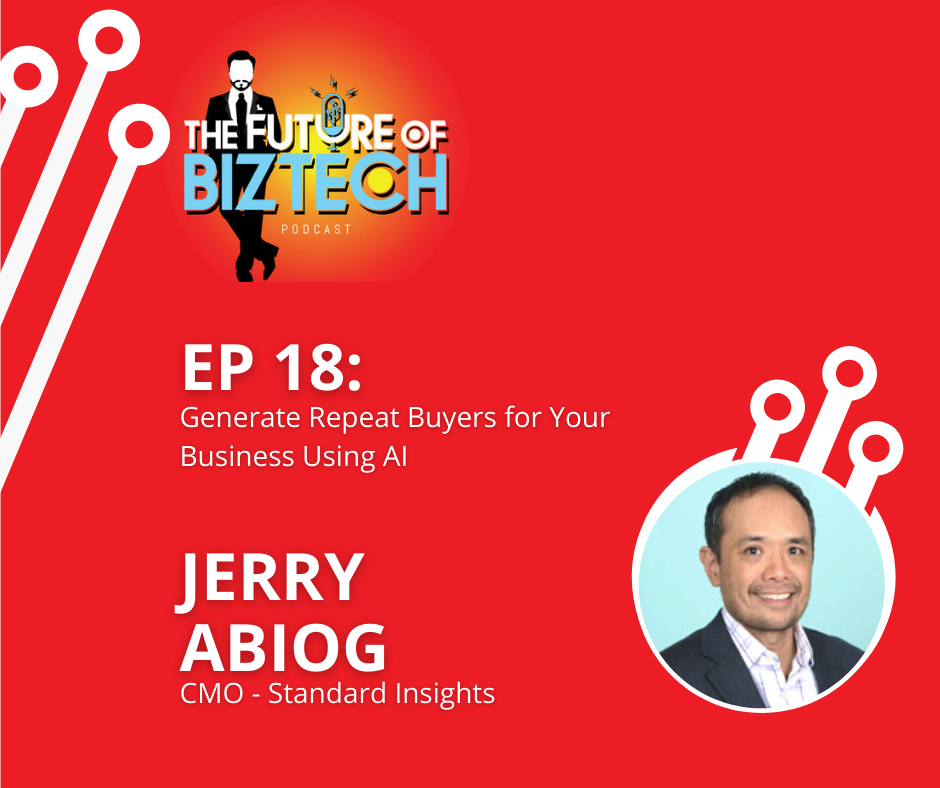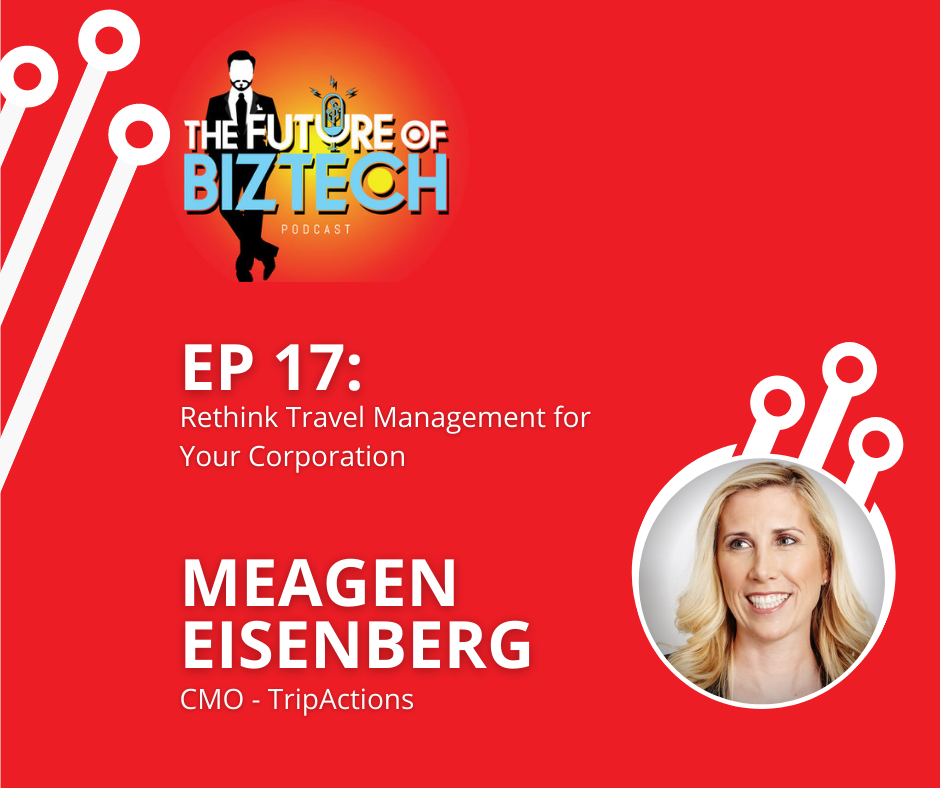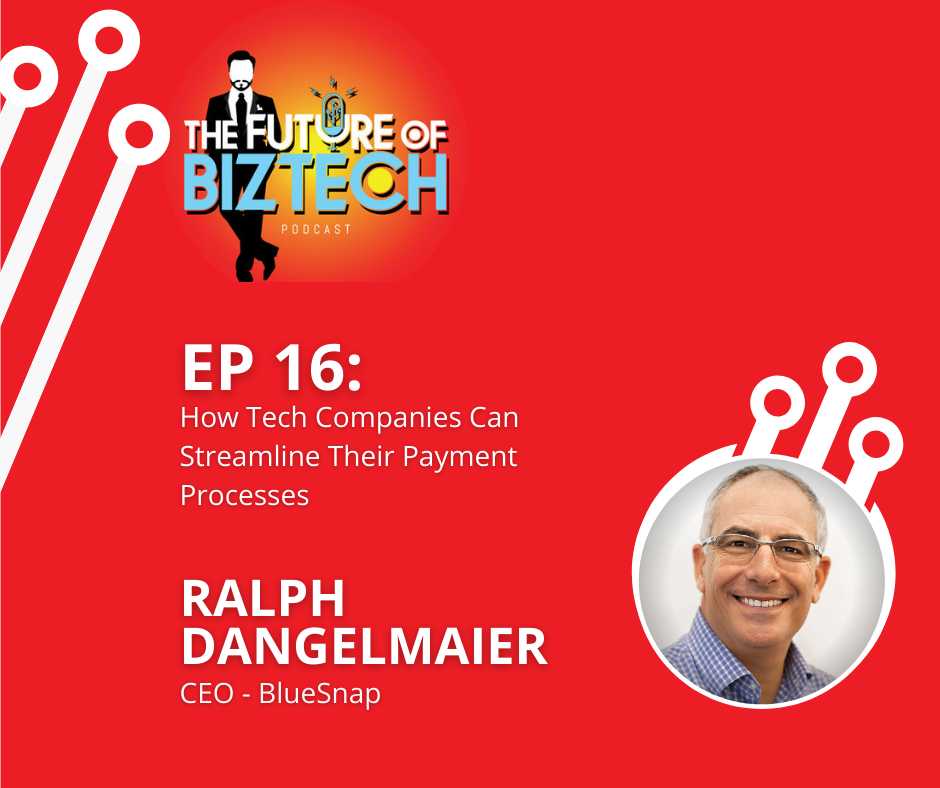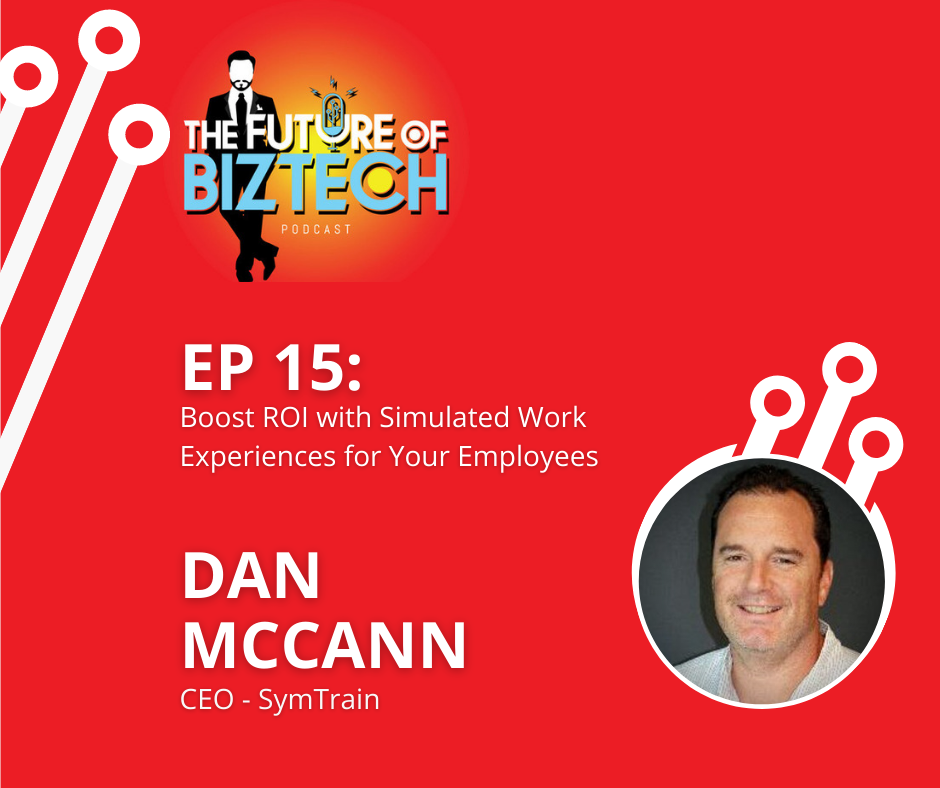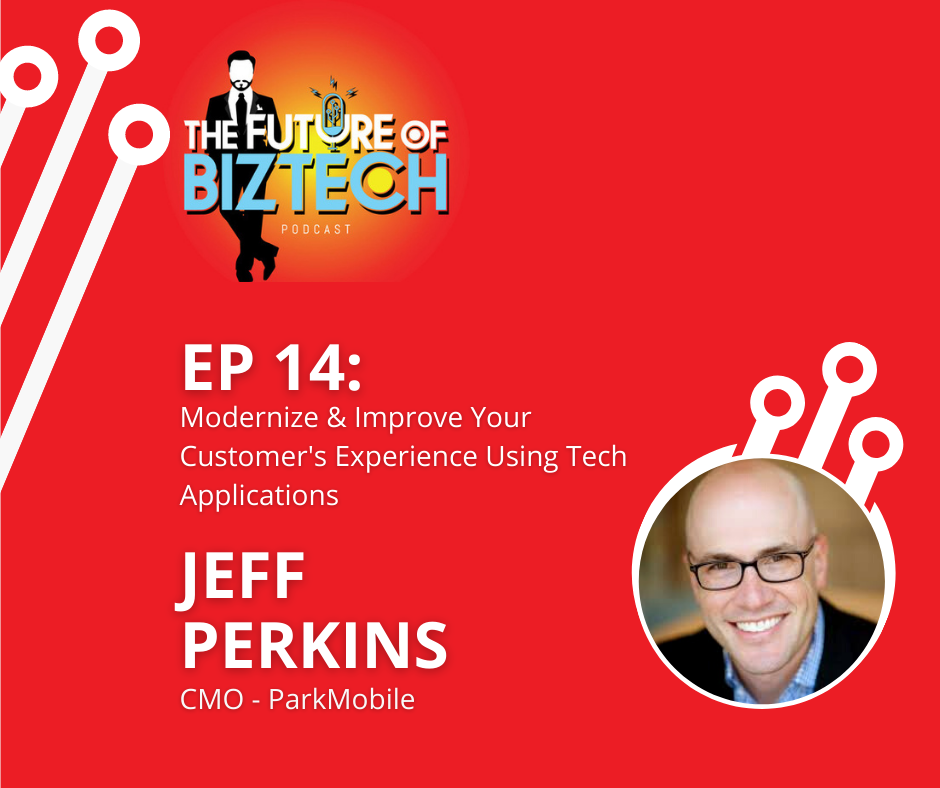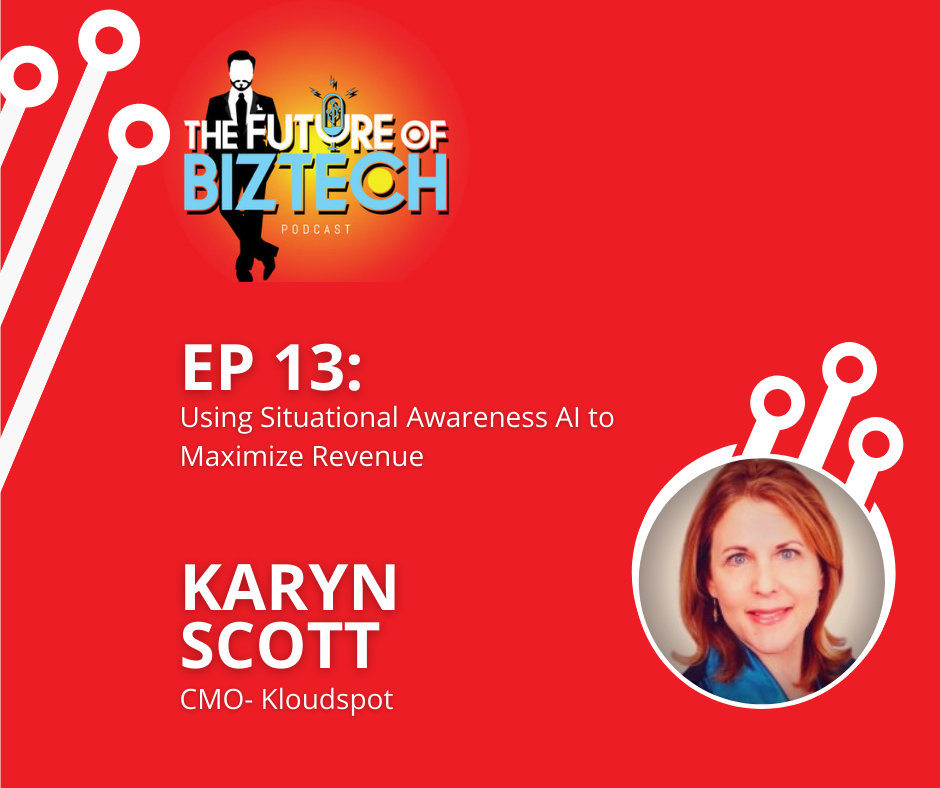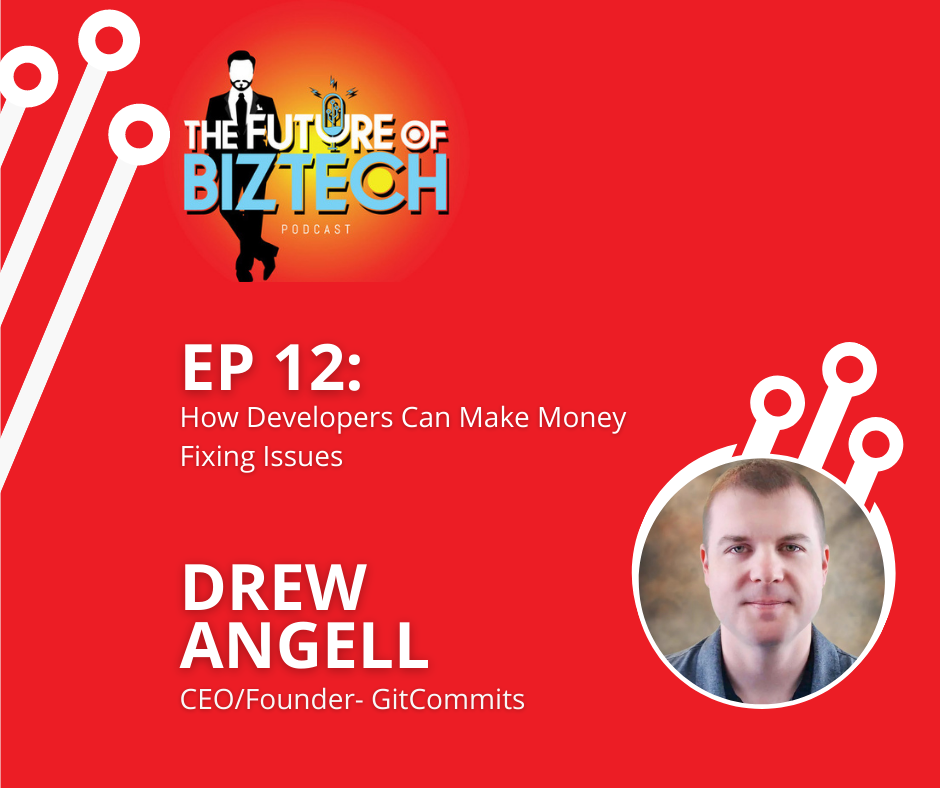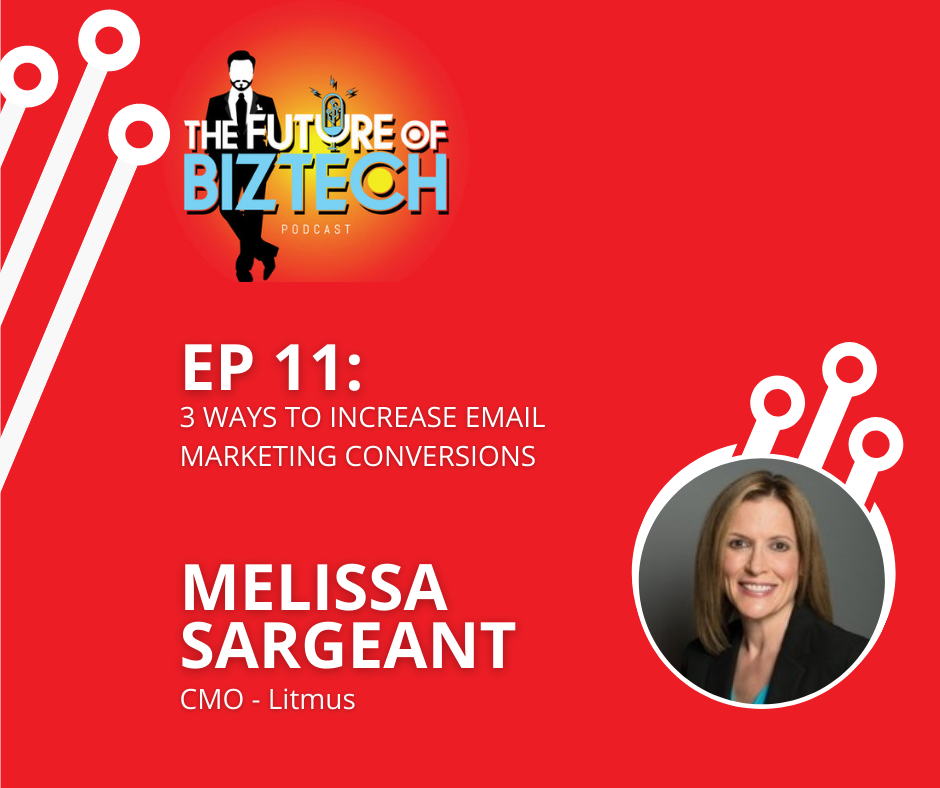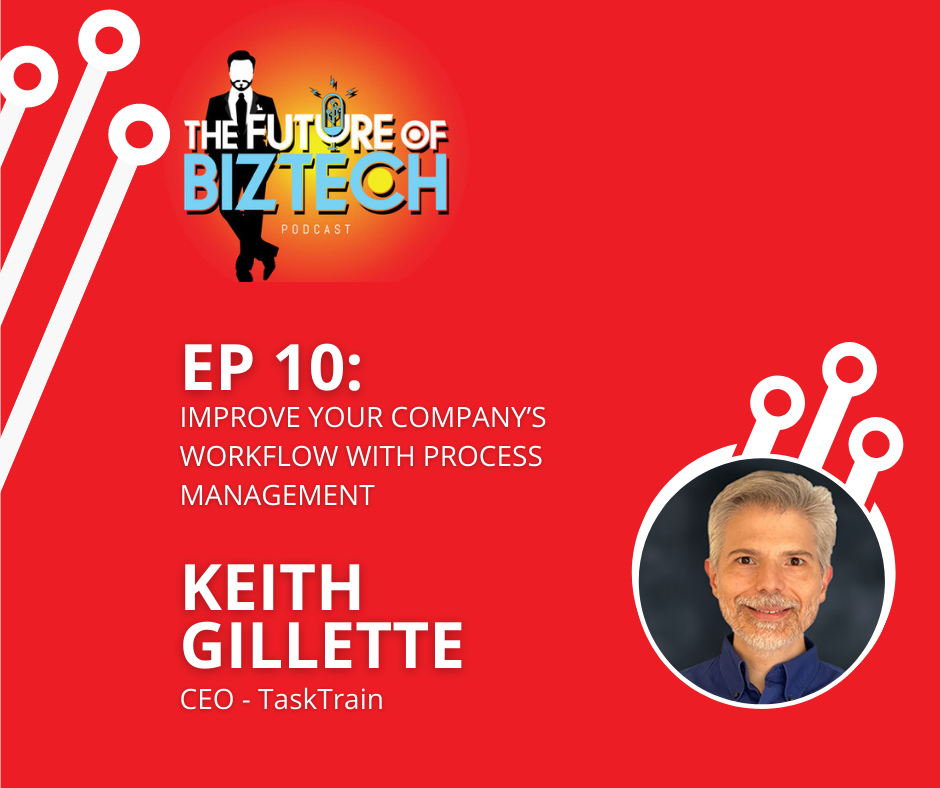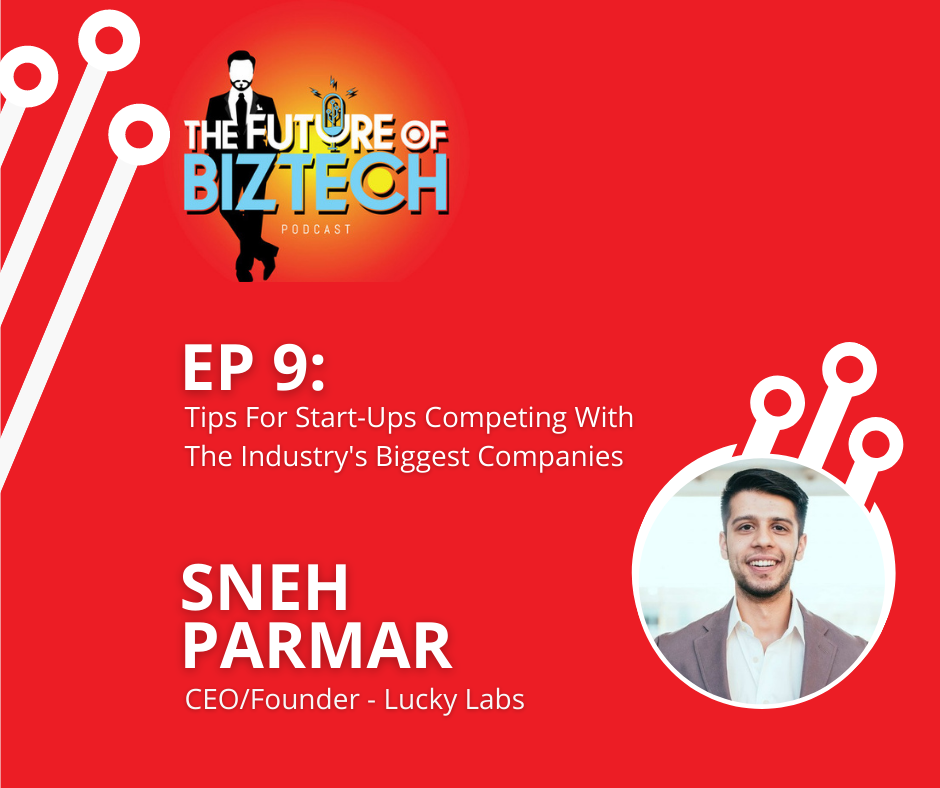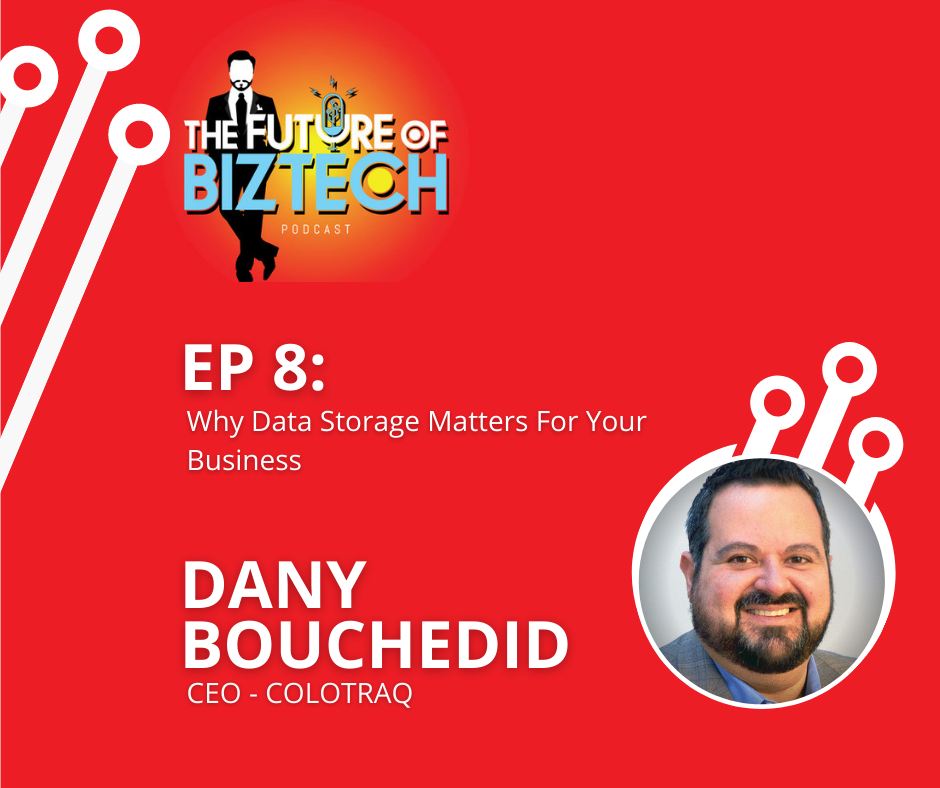JC: Well, welcome everybody to another episode of The Future of BizTech. I am your host, J.C. Granger. I am here with Dan McCann, the CEO of SymTrain. Dan, thank you so much for coming on. Tell the audience a little about yourself and your company, who help you out.
Dan: Yeah. Great, thanks JC. So my name’s Dan McCann and Founder of SymTrain. We started about three years ago. My background has been in the startup community really. I had founded a services company a lot like Infinity Marketing, where people were really important to us. And I ran that for about 15 years and we were doing outbound sales prospecting. And just a little bit of background on SymTrain, while we were there, we were kind of struggling to train people and get them up to speed fast enough and quick enough.
Dan: And it was a real problem for us because people were our product and their ability to deliver for our customers. So we spent a lot of time on that particular problem and over the years just tried a lot of different things. And finally, we realized folks learn by doing, right? And first and foremost, but it’s really expensive to drive a lot of resources to help one-on-one human-to-human train people. By doing so, most companies, myself included says, “Hey, go learn on the job. I’ll teach you everything you need to know, but then go do the job and you’ll figure it all out.” You’ll have that aha moment, JC.
Dan: And some people got it quickly and others didn’t and the ones that didn’t just got really frustrated and they leave. So from that perspective, we started investing in some technology that people could practice and learn what they’re doing in an environment where they’re not at risk and our clients weren’t at risk of learning on the job. And we had a great time with it. It worked out really well for us. And that time in that environment led us to this journey that said, “Hey, there’s an opportunity here for this technology and it’s kind of new.” We brought in a lot of conversational technology into it and voice as well as software and systems, and then started talking to the market and they said, “Yeah, there’s something here. We would pay for this. We would buy this.” So it worked out well for us given that journey and brought it to market. But being an entrepreneur at heart is kind of what led us to do this three years ago at SymTrain.
JC: So what does that look like from the ground level of another business utilizing your platform? I mean, can you kind of walk us through, for one, what types of businesses does it benefit the most just generically speaking and then if they were to go and say, “Okay well, I want to try this out,” what does that look like? What does their process and their flow user experience look like, and how does it make their day 10 times better than it would have been without it?
Dan: Yeah. Great. Thanks. Good question. And if you think about it, it’s because there’s conversations that take place and there’s also software or video. We have an ultimate vision of providing a digital coach for everyone, right? So that’s a big vision. And so early on, what we’ve done is said, okay, who does this really impact? Folks that are having interactions with other people, right? And what employees are doing that most often? So we’ve been targeting for the last couple years contact centers in your enterprise, your fortune 500 companies, those folks who have contact centers, where sales, service, support, even HR, where there’s a lot of interaction. And we just recently started getting this year into retail environments as well, where either obviously through the contact center originally where I’m talking to customers who are doing returns and that sort of or even purchases in an omni-channel way in terms of that communication.
Dan: So that’s really our target market. And what folks are doing, like I mentioned before with our own background, is we found that first off people don’t like to struggle, right? People don’t go into their job saying, “Hey, I’m going to give a half effort.” Right? But managers go, “Man, my people are giving half effort. I don’t understand it.” So there’s a little bit of a disconnect there and the key is people, they get nervous. They get scared. They actually fear the observation, right? And the Hawthorne effect of people watching me and observing me and that anxiety builds up and people start to shut down.
Dan: And so what our clients are doing is they’re putting their employees, whether they’ve been in role for 10 years or they’re brand new hires right out of school, into these what I call safe simulated environments to practice and learn how to execute a good conversation, how to execute a return from a customer, how to update a policy or sell and close a deal, or overcome an objection, do that in an environment where you could practice and learn and get repetition and even feedbacks because there’s a lot of analytics in SymTrain on how well you’re doing and you get feedback on that.
Dan: So what our customers are doing is they pick a couple of use cases and teams within their business and say, “Let’s go, let’s put the salespeople through objection handling.” Or, “Let’s do the onboarding training.” And it builds up over time, which is a great way we work with our customers is they can build content in here. It’s real simple environment. There’s no code. You don’t need developers or big technicians, which is definitely a competitive advantage for SymTrain compared to some other tools that are doing conversational AI and some analytics.
Dan: Yeah. So a client’s able to do that, put it in front of their employees, get instant feedback, not just on what their employees think like, “Hey, how’d it go?” “Yeah, this was great. Thank you.” But actually behavioral changes, they can see it right in SymTrain that they’re making an impact on their delivery, on their content of what they’re saying. Also the sentiment or emotional delivery, they’re getting scores back and they’re seeing the impact that people are making. So it’s not just on how well the training is going, but it actually, they can measure performance right within SymTrain that then applies to the floor. So the return on putting people through SymTrain is two to four weeks ROI in terms of going through this, which clients love. And then we just expand with them and continue to grow in other areas with our customers that way.
JC: Have you seen an uptick in business with the pandemic and companies going more remote having kind of forcing them to train people off site, or was this something that was used more in-house in an office environment?
Dan: So it’s a combination, JC, of both. So I mean, contact centers is our initial target market, right? And when you say your vision is a digital coach for everyone, we see a much greater future than that down the road. But our customers, these contact center folks are going virtual, right? So they’re not coming in to these contact centers and they’re going remote and they’re onboarding remote learners. What happened for us, to answer your question, COVID did provide a bit of a tailwind for us, changed the world, right? But for some companies it provided a tailwind, because now you’re onboarding people remotely and they’re working virtually and you have to keep them engaged, right? And you keep them focused and executing.
Dan: But you don’t have the resource to do that. And you have these breakout rooms in Microsoft teams or Zoom, and you’re figuring out different delivery models. But with SymTrain, employees are able to work on their own, go through the repetition, get a feel for it. And then when they get back together with their groups, they’re doing better. They’re more confident. And so yeah, it did help us. I mean, in fairness this year, we grew a lot and the impact of COVID did help as customers are bringing on more remote workers and trying to drive a higher level of engagement without losing any performance capabilities.
JC: And how long would you say you’ve had the company? Did you start it? Did you come in later?
Dan: Yeah. So it’s three years, we’ve been at it at SymTrain and it was developed or incubated in that prior company that I owned, right? That sales prospecting business that’s still active today and they still use our software at SymTrain, but we started it there. We incubated it and we realized they were doing sales prospecting for B2B, but there was a much bigger market for SymTraining, if you will, and people getting this exposure and those other roles, service, support, HR in addition to sales, right? Big impact areas. So we broke it off three years ago, spun it out and have been going at it since then in terms of just time to market and how we got started in here.
JC: When did you realize… Starting a new company is a tough thing. I mean, I’ve been through it, you’ve been through it multiple times. When did you realize that SymTrain was going to make it? When did that anxiety of, oh crap, is this even going to work, when did that start to subside? What was that moment? I feel like everyone usually knows that moment when they were like, okay, we’re good.
Dan: Yeah. JC, so for Infinity Marketing, has it subsided you yet after 10 years?
JC: I don’t know, 10 years. I think my moment, I think was probably… Because I started with nothing. I mean, with what I had in my pocket, kind of thing. So I think my moment was when I realized that I had like 90 days of runway for rent, right? Then I was like, okay, all right, I got this. You know what I mean? But that day-to-day stuff was killer in the beginning. Kind of what was that for you?
Dan: Yeah. So this is awesome. So my point was maybe it never happens depending on the individual, but I think there were kind of two, right? The first one was what gave us the confidence to launch SymTrain in the first place. We saw the impact it was making, right? And we were trading North of 50% of our new hires, right? And the ones that we were bringing in, it was taking six months to get them to full speed and productivity. And the excuse, the reason excuse was, hey, this is really difficult. It’s challenging, not everyone can do it, but the answer was we just weren’t doing things effectively and well. And then when we brought the software and we realized, hey, look, it’s no longer taking us eight weeks to graduate 50% of our class, we were doing in two or three weeks.
Dan: And I was like, “Wow, this is huge.” Right? And they were doing way better. And then we were retaining so many more people that we started talking to folks in the marketplace like what do you think? Conversational simulations and having system navigation combined in these scenarios and situational training, what are you guys doing to performance-based training? And everyone said either, “We don’t do it. We learn on the job. So this is awesome.” Or, “Hey, it’s a very manual exercise for us. It’s very expensive and we wish we could do more. So your technology would be helpful.” So that was number one like wow, this is something we got to take to market. We realized this would be good. And then the other one is we signed up really big clients, right? Like top five or 10 in their industry sectors like banking, insurance, communication, even healthcare, retail, consumer products.
Dan: So once we got to renewals where we were anxious about the renewal, JC, and they were expanding and they’re saying, “Hey, we’re going into this and this area, and we’re going to take it over here. And here’s our game plan for SymTrain in our business.” We said, “Whoa, this is great.” That was the time where we felt, okay, there’s something here. We’re going to be able to make this work and grow it. So that was kind of the two points of time where we really felt good that we had something that was going to be successful.
JC: That’s cool. I’m a marketing guy, you know that, right? That’s where my head’s always at. A lot of the audience is in that tech industry, a lot of them are owners of their own businesses, or they’re going to be starting up their own, what can you tell the people listening like what are you guys doing for marketing to keep yourself relevant and out there, right? How are you staying ahead of competitors? Are you doing more direct outreach because you’re going top shelf? Are you doing more inbound and content? What gives SymTrain a flow from eyes on the page angle, right?
Dan: I think we are an outbound organization. And what that means for folks listening is we do a lot of outreach to very targeted accounts and targeted personas within those accounts, right? And we get our message to them via social, via email, via phone. It’s a lot of prospecting oriented activities. I will tell you wildly envious of those inbound organizations that have perfected and mastered the approach of being able to target because our target is so pinpointed today, right? And we have very specific industries, very specific roles and titles and value prop for them. But we’re starting to drive a little bit more content this year.
Dan: And that’s part of our goal. And our roadmap is to start to compliment our outbound efforts with content in the market, folks could see us as experts in our space and can look to say, “Hey, we need performance-based training and assessment. And we don’t have the resource or the time or the budget to do it with humans so if we can automate that, who knows about that?” Right? So SymTrain’s one of those unique folks. So that’s on our roadmap and we’re aspirational to create, JC, that inbound environment. But definitely for us, it’s all been outbound and it’s been very targeted in our efforts.
JC: I’m going to ask you a personal question. I haven’t asked much on the show yet, but I want to ask you, what did you want to be when you grew up, so to speak? Like when you were a kid, what was your dream job? And if it wasn’t this, then how did you get to this?
Dan: Yeah, that’s an awesome question. So when I was a little kid, I wanted to be a cowboy and then I wanted to be a pilot up until about eight or so. But then once I got into middle school, I always wanted to be a teacher, right? I wanted to coach. I was an athlete throughout my childhood and into high school and college. I played baseball through college and still play today even as an old man. I haven’t given that up but I really love coaching and developing those people that are with me or folks on my team. So I always wanted to be a teacher, right? And so in the-
JC: That’s very relevant to what you’re doing now. I mean, you basically tried to automate teaching for people to help their employees. That’s pretty fantastic.
Dan: It’s exactly right. And so my prior job, I started that company where we were doing prospecting, you couldn’t get me out of training, right? Like Dan, you own the company, you’re the COO, you need to do other things, you can’t do training, but I was so passionate and I loved it. You’re exactly right. It’s kind of led to this journey to SymTrain where it’s exactly what I’m doing right now. I’m doing teaching and it’s the environment I’ve always wanted to be in, especially in this learn by doing approach that SymTrain has with our customers, right? So all their employees can come in and learn how to do their job by actually performing job functions and tasks and develop those skills in this simulated environment. So yeah, very much I am able to do now what I aspired to do as a young kid.
JC: That’s awesome. That’s cool. Now, as far as again, people listening, you’ve talked about how you work with really big companies. So the impression might be that it’s really expensive and I don’t have to necessarily hear your price points unless you want to give them, but how does it work? I mean, can small businesses use you at a lower level or is it a per license? Like just how is your model when it comes to payment? Just in general, how does your pricing structure work? Is it all top end, contracts only or do you have like someone could sign up online and free trial it? How does it work?
Dan: Yeah. Great question. So we’re not quite at the point yet where you can sign up online and free trial it, we will get there probably by the end of this year and get to that point. But what’s unique about how we go to market is there’s no real front end costs, you don’t have to make a huge investment in SymTrain, right? So what you can do is you could actually just pay for usage. So some of our clients come in and they pay us and say, “Hey, we’re just going to use X amount. We might have 20,000 employees, but we want to use this with these 100 employees.” Right? So they just pay for that amount. So it’s a very low barrier of entry to get in and start using us, which to your question does allow mid markets to participate the same as larger.
Dan: The key for SymTrain is because you’re automating a very manual activity, you think about it, it’s like people don’t love role-play. Some like it more than others. I’m one of those weirdos that love it, right? I just love doing role-play and exercises with my peers. I would actually call people up before I got started and role play with them and not even tell them I was doing it, right? And they’re like, “What are you doing Dan?” And I’m like, “Oh, I’m just getting ready for the day.” But that was kind of unique, but being able to provide that environment, you kind of need a certain level, right? With five employees or 10, there’s no really need for automating those efforts, right?
Dan: But once you get North of 50 to 100 and you’ve got multiple managers and you got a lot of people you’re bringing on and they’re doing these tasks in new hire and in role, it starts to make more sense North of 100 people. But the good news is cost-wise, it’s real simple. So you’re going to make an impact early because you’re not really paying these huge upfront fees and cost to bring SymTraining in-house.
JC: Got it. With the nature of the podcast, the Future of BizTech, can you tell the audience something that’s going to be coming down the pipeline? Like what’s SymTrain’s coming up with next and then secondary to that, where do you see the automation of training going in the future for industries? So kind of what’s coming in the future for your company and then where do you see the future of what you do in general going in business?
Dan: Yeah. So a couple things, right? So on the technology side, I mentioned it’s very lightweight. So what SymTrain has done that’s pretty unique and the reason… There’s folks in the market that do simulations and it’s a big heavy lift, right? And so it’s a big cost tied to it, but with SymTrain, we’re using a lot of contemporary technology, a lot of companies are spending tons of money on voice, on AI, Siri, Alexa, and these are big companies with billions and billions of dollars behind, and we’re able to leverage what they’re doing and put it into a very unique deliverable, right? So what’s down the road is easier access for folks, right? Got mobile access today, in the contact center, you’re doing things on your IVR systems or your phone systems, if you will, being able to distribute content through LMS, through workforce management solutions where customers spend a lot of their time.
Dan: So that’s a really great piece of it. And then the other side is a higher level of authenticity, right? And you look at some of those Alexa or Siri scenarios and they’re getting better and better. And so is SymTrain creating more authentic conversations and more customizable, dynamic flows within a dialogue, which is really exciting for us, right? And a lot of our clients or prospects when they talk about it like, “Oh, kind of we get it,” you’re going in and you’re making decisions and you have decision trees. And our answer is no, you’re not making any decisions. You’re actually executing on these scenarios in SymTrain, which is uniquely different than a lot of the technology that’s out there today.
Dan: You don’t decide on what are you going to do next, you actually do it in SymTrain, which is awesome, right? So focusing more and more on that and tying that closer to the production floor. And we’re spending a lot of time, JC, just in our offering environment and developing content because our customers have a lot of this content in-house it just happens to be sitting in a data warehouse somewhere or so they have bought it-
JC: They’re sitting on the goldmine, but they don’t know how to get the gold out.
Dan: Correct.
JC: You’re the mining company that can extract it from the mine, so to speak. It’s all there, it’s just not organized and useful at the moment.
Dan: 100%. That’s exactly right.
JC: You’ve got to put that in your sales material now. So you’re right there. That’s for you. That’s a gift.
Dan: I love it.
JC: I just gave you that analogy.
Dan: Well, JC, I’ll take it. The gold mine that’s in-house that you’re able to extract.
JC: Yeah. You’re the mining company.
Dan: It’s awesome. The mining company for training content that… Yeah. I love it. I love it.
JC: If I don’t see this website update, I’m going to be offended.
Dan: We definitely will. We definitely will. So I mean, here’s the good news, right? We are talking about the future of SymTrain too. So those are things we’re working on now. So this website update might be six months out versus six days out, by the way. But yeah, so there’s a lot of great stuff that’s happening with voice technology today and it’s becoming way more mainstream. I mentioned we’ve been at it for three years, right? So three years ago we had to do a lot of explaining, hey, voice in conversations and tying that to software or video and recreating scenarios, we don’t get it.
Dan: A lot of our prospects and suspects, they get it now way more like, “Oh, can you do this or that?” “Yeah, absolutely.” “Hey, let me see it. Can I take a look?” So which is definitely one way our customers love to pull back the onion and see is just getting a demo or taking a look at how SymTrain can work with scenarios that are very similar to the problems and struggles they have with getting folks to be able to perform their job and drive a certain level of expertise.
JC: That’s awesome. Listen, I love what you guys are doing there. I can tell you right now from my personal experience, I wasn’t even able to grow as an agency effectively until I figured out how to automate that training process. And because I would say that the difference between an entrepreneur and a CEO is the ability to let go. You don’t have to like it because I don’t like it, right? You just have to accept it. You have to do it anyway. And the only way to do that is to take a large part of that training and whatnot off your plate. But what I find is that as a CEO, it’s hard to trust someone else to do it the way I would do it. So when you set up your own training, the way that you would train someone, you feel better that all you have is managers pointing those employees to that training.
JC: You can update it now or you can have your people update it a little bit but when the core of your training comes from the top, the person who has the most vested interest in it financially, emotionally, mentally, I find that that makes me feel a lot better, that anxiety subside you. You talked about two moments. My second moment was when I started automating the training for my company because I was like, wow, I don’t have to worry about is this person going to do it the way I would do it because I just told them how I do it. So will they do it every time the way I do? No, but again, that is part of letting go if you’re going to expand otherwise you’re an entrepreneur, that’s it, right? And there’s a lot of those and that’s still very small percent of the population and there’s nothing to be ashamed of being a small business entrepreneur. That’s a lifestyle.
Dan: And you own your own job at that point, JC.
JC: Absolutely. But if you want to grow, if your goal is to expand and be multi multi-million or have investors, things like that, you got to let it go, but this is a great organized way to do it, where you feel more comfortable that the way things are going to happen or the way you would do them yourself. So I think what you guys are doing is great. Thank you so much for being on the show and also for providing such great service just to B2B or for businesses in general. How can people reach out either to you, to the company, if they hear this and they go, “Holy crap, I want to talk more,” what’s a good contact?
Dan: Yeah. So we have a contact me on the website at symtrain.com. There’s a video on there that walks through how SymTrain works so people can see that and reach out.
JC: And for audio… Because we have video going, but for audio, for podcast listeners SymTrain is spelled S-Y-M-T-R-A-I-N, correct?
Dan: Yeah. Thank you. Definitely. Yeah, symtrain.com.
JC: Yeah. Just want to make sure.
Dan: We did buy the SIM as well, so it’ll-
JC: Okay. All right. So even if they go to the other one, okay.
Dan: That’s perfect. And which helps because you can reach out to me directly, I’m Dan.McCann, M-C-C-A-N-N. I love talking to folks about the problem and the challenges and getting into an initial discussion. I even love demoing the product, obviously. So if folks reached out to me, that would be awesome. Love to talk to them about challenges they’re having and onboarding folks or change management with their in role people or helping even develop leadership traits within their organization, right? So that level of consistency across business functions and departments is a huge value add. So we have clients who just work with us on delivering new software, a new process out to their folks in the field or in role, and they can do consistent delivery and getting people performing those within SymTrain before they have to take it live on the job. So yeah, love to talk to folks.
JC: I think that’s really great that you’re offering your personal contact info because I think just the fact that you have the time to even tell people they can reach out to you on their own means that you’re obviously using SymTrain for yourself, right? I mean, like we just said, there’s no way you can take that kind of time off your plate unless you’re automating those other things. So again, thank you so much for being on the show. Thanks for letting our audience contact you directly if they like. And I look forward to seeing my goldmine line on your website sometime.
Dan: It’ll be there. It’ll definitely be there.
JC: Thanks so much, Dan.
Dan: Right. And I appreciate what you’re doing, right? Future of BizTech, it’s important stuff, right? And getting folks ready to perform whatever the technology is to automate different functions within the business, it’s really important. So thanks for doing this, JC.
JC: Yeah. No, my pleasure. I’m just a tech nerd who always likes to know what’s coming next. So this is my way of finding out firsthand before anyone else, right? Thanks Dan for coming on. Talk to you soon.
Dan: Great talking to you again, take care. See you, JC.
JC: Well, welcome everybody to another episode of The Future of BizTech. I am your host, J.C. Granger. I am here with Dan McCann, the CEO of SymTrain. Dan, thank you so much for coming on. Tell the audience a little about yourself and your company, who help you out.
Dan: Yeah. Great, thanks JC. So my name’s Dan McCann and Founder of SymTrain. We started about three years ago. My background has been in the startup community really. I had founded a services company a lot like Infinity Marketing, where people were really important to us. And I ran that for about 15 years and we were doing outbound sales prospecting. And just a little bit of background on SymTrain, while we were there, we were kind of struggling to train people and get them up to speed fast enough and quick enough.
Dan: And it was a real problem for us because people were our product and their ability to deliver for our customers. So we spent a lot of time on that particular problem and over the years just tried a lot of different things. And finally, we realized folks learn by doing, right? And first and foremost, but it’s really expensive to drive a lot of resources to help one-on-one human-to-human train people. By doing so, most companies, myself included says, “Hey, go learn on the job. I’ll teach you everything you need to know, but then go do the job and you’ll figure it all out.” You’ll have that aha moment, JC.
Dan: And some people got it quickly and others didn’t and the ones that didn’t just got really frustrated and they leave. So from that perspective, we started investing in some technology that people could practice and learn what they’re doing in an environment where they’re not at risk and our clients weren’t at risk of learning on the job. And we had a great time with it. It worked out really well for us. And that time in that environment led us to this journey that said, “Hey, there’s an opportunity here for this technology and it’s kind of new.” We brought in a lot of conversational technology into it and voice as well as software and systems, and then started talking to the market and they said, “Yeah, there’s something here. We would pay for this. We would buy this.” So it worked out well for us given that journey and brought it to market. But being an entrepreneur at heart is kind of what led us to do this three years ago at SymTrain.
JC: So what does that look like from the ground level of another business utilizing your platform? I mean, can you kind of walk us through, for one, what types of businesses does it benefit the most just generically speaking and then if they were to go and say, “Okay well, I want to try this out,” what does that look like? What does their process and their flow user experience look like, and how does it make their day 10 times better than it would have been without it?
Dan: Yeah. Great. Thanks. Good question. And if you think about it, it’s because there’s conversations that take place and there’s also software or video. We have an ultimate vision of providing a digital coach for everyone, right? So that’s a big vision. And so early on, what we’ve done is said, okay, who does this really impact? Folks that are having interactions with other people, right? And what employees are doing that most often? So we’ve been targeting for the last couple years contact centers in your enterprise, your fortune 500 companies, those folks who have contact centers, where sales, service, support, even HR, where there’s a lot of interaction. And we just recently started getting this year into retail environments as well, where either obviously through the contact center originally where I’m talking to customers who are doing returns and that sort of or even purchases in an omni-channel way in terms of that communication.
Dan: So that’s really our target market. And what folks are doing, like I mentioned before with our own background, is we found that first off people don’t like to struggle, right? People don’t go into their job saying, “Hey, I’m going to give a half effort.” Right? But managers go, “Man, my people are giving half effort. I don’t understand it.” So there’s a little bit of a disconnect there and the key is people, they get nervous. They get scared. They actually fear the observation, right? And the Hawthorne effect of people watching me and observing me and that anxiety builds up and people start to shut down.
Dan: And so what our clients are doing is they’re putting their employees, whether they’ve been in role for 10 years or they’re brand new hires right out of school, into these what I call safe simulated environments to practice and learn how to execute a good conversation, how to execute a return from a customer, how to update a policy or sell and close a deal, or overcome an objection, do that in an environment where you could practice and learn and get repetition and even feedbacks because there’s a lot of analytics in SymTrain on how well you’re doing and you get feedback on that.
Dan: So what our customers are doing is they pick a couple of use cases and teams within their business and say, “Let’s go, let’s put the salespeople through objection handling.” Or, “Let’s do the onboarding training.” And it builds up over time, which is a great way we work with our customers is they can build content in here. It’s real simple environment. There’s no code. You don’t need developers or big technicians, which is definitely a competitive advantage for SymTrain compared to some other tools that are doing conversational AI and some analytics.
Dan: Yeah. So a client’s able to do that, put it in front of their employees, get instant feedback, not just on what their employees think like, “Hey, how’d it go?” “Yeah, this was great. Thank you.” But actually behavioral changes, they can see it right in SymTrain that they’re making an impact on their delivery, on their content of what they’re saying. Also the sentiment or emotional delivery, they’re getting scores back and they’re seeing the impact that people are making. So it’s not just on how well the training is going, but it actually, they can measure performance right within SymTrain that then applies to the floor. So the return on putting people through SymTrain is two to four weeks ROI in terms of going through this, which clients love. And then we just expand with them and continue to grow in other areas with our customers that way.
JC: Have you seen an uptick in business with the pandemic and companies going more remote having kind of forcing them to train people off site, or was this something that was used more in-house in an office environment?
Dan: So it’s a combination, JC, of both. So I mean, contact centers is our initial target market, right? And when you say your vision is a digital coach for everyone, we see a much greater future than that down the road. But our customers, these contact center folks are going virtual, right? So they’re not coming in to these contact centers and they’re going remote and they’re onboarding remote learners. What happened for us, to answer your question, COVID did provide a bit of a tailwind for us, changed the world, right? But for some companies it provided a tailwind, because now you’re onboarding people remotely and they’re working virtually and you have to keep them engaged, right? And you keep them focused and executing.
Dan: But you don’t have the resource to do that. And you have these breakout rooms in Microsoft teams or Zoom, and you’re figuring out different delivery models. But with SymTrain, employees are able to work on their own, go through the repetition, get a feel for it. And then when they get back together with their groups, they’re doing better. They’re more confident. And so yeah, it did help us. I mean, in fairness this year, we grew a lot and the impact of COVID did help as customers are bringing on more remote workers and trying to drive a higher level of engagement without losing any performance capabilities.
JC: And how long would you say you’ve had the company? Did you start it? Did you come in later?
Dan: Yeah. So it’s three years, we’ve been at it at SymTrain and it was developed or incubated in that prior company that I owned, right? That sales prospecting business that’s still active today and they still use our software at SymTrain, but we started it there. We incubated it and we realized they were doing sales prospecting for B2B, but there was a much bigger market for SymTraining, if you will, and people getting this exposure and those other roles, service, support, HR in addition to sales, right? Big impact areas. So we broke it off three years ago, spun it out and have been going at it since then in terms of just time to market and how we got started in here.
JC: When did you realize… Starting a new company is a tough thing. I mean, I’ve been through it, you’ve been through it multiple times. When did you realize that SymTrain was going to make it? When did that anxiety of, oh crap, is this even going to work, when did that start to subside? What was that moment? I feel like everyone usually knows that moment when they were like, okay, we’re good.
Dan: Yeah. JC, so for Infinity Marketing, has it subsided you yet after 10 years?
JC: I don’t know, 10 years. I think my moment, I think was probably… Because I started with nothing. I mean, with what I had in my pocket, kind of thing. So I think my moment was when I realized that I had like 90 days of runway for rent, right? Then I was like, okay, all right, I got this. You know what I mean? But that day-to-day stuff was killer in the beginning. Kind of what was that for you?
Dan: Yeah. So this is awesome. So my point was maybe it never happens depending on the individual, but I think there were kind of two, right? The first one was what gave us the confidence to launch SymTrain in the first place. We saw the impact it was making, right? And we were trading North of 50% of our new hires, right? And the ones that we were bringing in, it was taking six months to get them to full speed and productivity. And the excuse, the reason excuse was, hey, this is really difficult. It’s challenging, not everyone can do it, but the answer was we just weren’t doing things effectively and well. And then when we brought the software and we realized, hey, look, it’s no longer taking us eight weeks to graduate 50% of our class, we were doing in two or three weeks.
Dan: And I was like, “Wow, this is huge.” Right? And they were doing way better. And then we were retaining so many more people that we started talking to folks in the marketplace like what do you think? Conversational simulations and having system navigation combined in these scenarios and situational training, what are you guys doing to performance-based training? And everyone said either, “We don’t do it. We learn on the job. So this is awesome.” Or, “Hey, it’s a very manual exercise for us. It’s very expensive and we wish we could do more. So your technology would be helpful.” So that was number one like wow, this is something we got to take to market. We realized this would be good. And then the other one is we signed up really big clients, right? Like top five or 10 in their industry sectors like banking, insurance, communication, even healthcare, retail, consumer products.
Dan: So once we got to renewals where we were anxious about the renewal, JC, and they were expanding and they’re saying, “Hey, we’re going into this and this area, and we’re going to take it over here. And here’s our game plan for SymTrain in our business.” We said, “Whoa, this is great.” That was the time where we felt, okay, there’s something here. We’re going to be able to make this work and grow it. So that was kind of the two points of time where we really felt good that we had something that was going to be successful.
JC: That’s cool. I’m a marketing guy, you know that, right? That’s where my head’s always at. A lot of the audience is in that tech industry, a lot of them are owners of their own businesses, or they’re going to be starting up their own, what can you tell the people listening like what are you guys doing for marketing to keep yourself relevant and out there, right? How are you staying ahead of competitors? Are you doing more direct outreach because you’re going top shelf? Are you doing more inbound and content? What gives SymTrain a flow from eyes on the page angle, right?
Dan: I think we are an outbound organization. And what that means for folks listening is we do a lot of outreach to very targeted accounts and targeted personas within those accounts, right? And we get our message to them via social, via email, via phone. It’s a lot of prospecting oriented activities. I will tell you wildly envious of those inbound organizations that have perfected and mastered the approach of being able to target because our target is so pinpointed today, right? And we have very specific industries, very specific roles and titles and value prop for them. But we’re starting to drive a little bit more content this year.
Dan: And that’s part of our goal. And our roadmap is to start to compliment our outbound efforts with content in the market, folks could see us as experts in our space and can look to say, “Hey, we need performance-based training and assessment. And we don’t have the resource or the time or the budget to do it with humans so if we can automate that, who knows about that?” Right? So SymTrain’s one of those unique folks. So that’s on our roadmap and we’re aspirational to create, JC, that inbound environment. But definitely for us, it’s all been outbound and it’s been very targeted in our efforts.
JC: I’m going to ask you a personal question. I haven’t asked much on the show yet, but I want to ask you, what did you want to be when you grew up, so to speak? Like when you were a kid, what was your dream job? And if it wasn’t this, then how did you get to this?
Dan: Yeah, that’s an awesome question. So when I was a little kid, I wanted to be a cowboy and then I wanted to be a pilot up until about eight or so. But then once I got into middle school, I always wanted to be a teacher, right? I wanted to coach. I was an athlete throughout my childhood and into high school and college. I played baseball through college and still play today even as an old man. I haven’t given that up but I really love coaching and developing those people that are with me or folks on my team. So I always wanted to be a teacher, right? And so in the-
JC: That’s very relevant to what you’re doing now. I mean, you basically tried to automate teaching for people to help their employees. That’s pretty fantastic.
Dan: It’s exactly right. And so my prior job, I started that company where we were doing prospecting, you couldn’t get me out of training, right? Like Dan, you own the company, you’re the COO, you need to do other things, you can’t do training, but I was so passionate and I loved it. You’re exactly right. It’s kind of led to this journey to SymTrain where it’s exactly what I’m doing right now. I’m doing teaching and it’s the environment I’ve always wanted to be in, especially in this learn by doing approach that SymTrain has with our customers, right? So all their employees can come in and learn how to do their job by actually performing job functions and tasks and develop those skills in this simulated environment. So yeah, very much I am able to do now what I aspired to do as a young kid.
JC: That’s awesome. That’s cool. Now, as far as again, people listening, you’ve talked about how you work with really big companies. So the impression might be that it’s really expensive and I don’t have to necessarily hear your price points unless you want to give them, but how does it work? I mean, can small businesses use you at a lower level or is it a per license? Like just how is your model when it comes to payment? Just in general, how does your pricing structure work? Is it all top end, contracts only or do you have like someone could sign up online and free trial it? How does it work?
Dan: Yeah. Great question. So we’re not quite at the point yet where you can sign up online and free trial it, we will get there probably by the end of this year and get to that point. But what’s unique about how we go to market is there’s no real front end costs, you don’t have to make a huge investment in SymTrain, right? So what you can do is you could actually just pay for usage. So some of our clients come in and they pay us and say, “Hey, we’re just going to use X amount. We might have 20,000 employees, but we want to use this with these 100 employees.” Right? So they just pay for that amount. So it’s a very low barrier of entry to get in and start using us, which to your question does allow mid markets to participate the same as larger.
Dan: The key for SymTrain is because you’re automating a very manual activity, you think about it, it’s like people don’t love role-play. Some like it more than others. I’m one of those weirdos that love it, right? I just love doing role-play and exercises with my peers. I would actually call people up before I got started and role play with them and not even tell them I was doing it, right? And they’re like, “What are you doing Dan?” And I’m like, “Oh, I’m just getting ready for the day.” But that was kind of unique, but being able to provide that environment, you kind of need a certain level, right? With five employees or 10, there’s no really need for automating those efforts, right?
Dan: But once you get North of 50 to 100 and you’ve got multiple managers and you got a lot of people you’re bringing on and they’re doing these tasks in new hire and in role, it starts to make more sense North of 100 people. But the good news is cost-wise, it’s real simple. So you’re going to make an impact early because you’re not really paying these huge upfront fees and cost to bring SymTraining in-house.
JC: Got it. With the nature of the podcast, the Future of BizTech, can you tell the audience something that’s going to be coming down the pipeline? Like what’s SymTrain’s coming up with next and then secondary to that, where do you see the automation of training going in the future for industries? So kind of what’s coming in the future for your company and then where do you see the future of what you do in general going in business?
Dan: Yeah. So a couple things, right? So on the technology side, I mentioned it’s very lightweight. So what SymTrain has done that’s pretty unique and the reason… There’s folks in the market that do simulations and it’s a big heavy lift, right? And so it’s a big cost tied to it, but with SymTrain, we’re using a lot of contemporary technology, a lot of companies are spending tons of money on voice, on AI, Siri, Alexa, and these are big companies with billions and billions of dollars behind, and we’re able to leverage what they’re doing and put it into a very unique deliverable, right? So what’s down the road is easier access for folks, right? Got mobile access today, in the contact center, you’re doing things on your IVR systems or your phone systems, if you will, being able to distribute content through LMS, through workforce management solutions where customers spend a lot of their time.
Dan: So that’s a really great piece of it. And then the other side is a higher level of authenticity, right? And you look at some of those Alexa or Siri scenarios and they’re getting better and better. And so is SymTrain creating more authentic conversations and more customizable, dynamic flows within a dialogue, which is really exciting for us, right? And a lot of our clients or prospects when they talk about it like, “Oh, kind of we get it,” you’re going in and you’re making decisions and you have decision trees. And our answer is no, you’re not making any decisions. You’re actually executing on these scenarios in SymTrain, which is uniquely different than a lot of the technology that’s out there today.
Dan: You don’t decide on what are you going to do next, you actually do it in SymTrain, which is awesome, right? So focusing more and more on that and tying that closer to the production floor. And we’re spending a lot of time, JC, just in our offering environment and developing content because our customers have a lot of this content in-house it just happens to be sitting in a data warehouse somewhere or so they have bought it-
JC: They’re sitting on the goldmine, but they don’t know how to get the gold out.
Dan: Correct.
JC: You’re the mining company that can extract it from the mine, so to speak. It’s all there, it’s just not organized and useful at the moment.
Dan: 100%. That’s exactly right.
JC: You’ve got to put that in your sales material now. So you’re right there. That’s for you. That’s a gift.
Dan: I love it.
JC: I just gave you that analogy.
Dan: Well, JC, I’ll take it. The gold mine that’s in-house that you’re able to extract.
JC: Yeah. You’re the mining company.
Dan: It’s awesome. The mining company for training content that… Yeah. I love it. I love it.
JC: If I don’t see this website update, I’m going to be offended.
Dan: We definitely will. We definitely will. So I mean, here’s the good news, right? We are talking about the future of SymTrain too. So those are things we’re working on now. So this website update might be six months out versus six days out, by the way. But yeah, so there’s a lot of great stuff that’s happening with voice technology today and it’s becoming way more mainstream. I mentioned we’ve been at it for three years, right? So three years ago we had to do a lot of explaining, hey, voice in conversations and tying that to software or video and recreating scenarios, we don’t get it.
Dan: A lot of our prospects and suspects, they get it now way more like, “Oh, can you do this or that?” “Yeah, absolutely.” “Hey, let me see it. Can I take a look?” So which is definitely one way our customers love to pull back the onion and see is just getting a demo or taking a look at how SymTrain can work with scenarios that are very similar to the problems and struggles they have with getting folks to be able to perform their job and drive a certain level of expertise.
JC: That’s awesome. Listen, I love what you guys are doing there. I can tell you right now from my personal experience, I wasn’t even able to grow as an agency effectively until I figured out how to automate that training process. And because I would say that the difference between an entrepreneur and a CEO is the ability to let go. You don’t have to like it because I don’t like it, right? You just have to accept it. You have to do it anyway. And the only way to do that is to take a large part of that training and whatnot off your plate. But what I find is that as a CEO, it’s hard to trust someone else to do it the way I would do it. So when you set up your own training, the way that you would train someone, you feel better that all you have is managers pointing those employees to that training.
JC: You can update it now or you can have your people update it a little bit but when the core of your training comes from the top, the person who has the most vested interest in it financially, emotionally, mentally, I find that that makes me feel a lot better, that anxiety subside you. You talked about two moments. My second moment was when I started automating the training for my company because I was like, wow, I don’t have to worry about is this person going to do it the way I would do it because I just told them how I do it. So will they do it every time the way I do? No, but again, that is part of letting go if you’re going to expand otherwise you’re an entrepreneur, that’s it, right? And there’s a lot of those and that’s still very small percent of the population and there’s nothing to be ashamed of being a small business entrepreneur. That’s a lifestyle.
Dan: And you own your own job at that point, JC.
JC: Absolutely. But if you want to grow, if your goal is to expand and be multi multi-million or have investors, things like that, you got to let it go, but this is a great organized way to do it, where you feel more comfortable that the way things are going to happen or the way you would do them yourself. So I think what you guys are doing is great. Thank you so much for being on the show and also for providing such great service just to B2B or for businesses in general. How can people reach out either to you, to the company, if they hear this and they go, “Holy crap, I want to talk more,” what’s a good contact?
Dan: Yeah. So we have a contact me on the website at symtrain.com. There’s a video on there that walks through how SymTrain works so people can see that and reach out.
JC: And for audio… Because we have video going, but for audio, for podcast listeners SymTrain is spelled S-Y-M-T-R-A-I-N, correct?
Dan: Yeah. Thank you. Definitely. Yeah, symtrain.com.
JC: Yeah. Just want to make sure.
Dan: We did buy the SIM as well, so it’ll-
JC: Okay. All right. So even if they go to the other one, okay.
Dan: That’s perfect. And which helps because you can reach out to me directly, I’m Dan.McCann, M-C-C-A-N-N. I love talking to folks about the problem and the challenges and getting into an initial discussion. I even love demoing the product, obviously. So if folks reached out to me, that would be awesome. Love to talk to them about challenges they’re having and onboarding folks or change management with their in role people or helping even develop leadership traits within their organization, right? So that level of consistency across business functions and departments is a huge value add. So we have clients who just work with us on delivering new software, a new process out to their folks in the field or in role, and they can do consistent delivery and getting people performing those within SymTrain before they have to take it live on the job. So yeah, love to talk to folks.
JC: I think that’s really great that you’re offering your personal contact info because I think just the fact that you have the time to even tell people they can reach out to you on their own means that you’re obviously using SymTrain for yourself, right? I mean, like we just said, there’s no way you can take that kind of time off your plate unless you’re automating those other things. So again, thank you so much for being on the show. Thanks for letting our audience contact you directly if they like. And I look forward to seeing my goldmine line on your website sometime.
Dan: It’ll be there. It’ll definitely be there.
JC: Thanks so much, Dan.
Dan: Right. And I appreciate what you’re doing, right? Future of BizTech, it’s important stuff, right? And getting folks ready to perform whatever the technology is to automate different functions within the business, it’s really important. So thanks for doing this, JC.
JC: Yeah. No, my pleasure. I’m just a tech nerd who always likes to know what’s coming next. So this is my way of finding out firsthand before anyone else, right? Thanks Dan for coming on. Talk to you soon.
Dan: Great talking to you again, take care. See you, JC.
